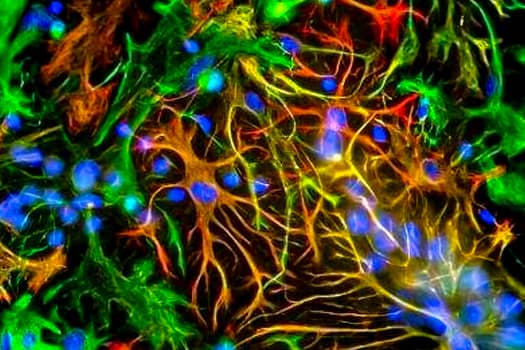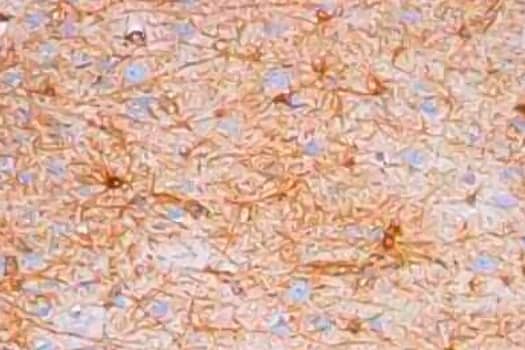GFAP, a class-III intermediate filament, is a 50kDa protein which is found in the mature and developing astrocytes in the CNS, non-myelinating Schwann cells in the PNS, enteric glial cells (enteric nervous system/ENS), ependymal cells, and radial glia of the developing brain. GFAP antibodies are the most widely used marker for astrocytes in neurological studies and along with its breakdown products (BDPs), GFAP has been proposed as a useful candidates for biofluid-based markers for numerous neurological conditions especially during traumatic brain/spinal cord injury and stroke [1]. Moreover, neuro-oncology studies have established a positive reaction to GFAP in astrocytomas, ependymoma, and astrocytic cells of mixed gliomas, subependymal giant cell astrocytoma, pleomorphic xanthoastrocytoma, astroblastoma, and gliosarcoma [2].

GFAP Antibody [NB300-141] - Mixed neuron-glial cultures stained with GFAP antibody NB300-141 (red) and Vimentin antibody NB300-223 (green). The fibroblastic cells contain only Vimentin and so are green. The astrocytes contain either Vimentin and GFAP (appearing golden) or predominantly GFAP (appearing red). Blue is nuclear DNA stain.

GFAP Antibody (GA5) [NBP2-29415] - Formalin fixed paraffin embedded human brain tissue section stained with GFAP antibody clone GA-5 detected using HRP-labeled secondary and DAB followed by counterstaining with hematoxylin. The antibody specifically stained the astrocytes in the tested tissue section.
Bio-Techne offers a range of high quality GFAP Antibodies which are cited in research publications from high impact journals.
Dr Pierantoni's group from University of Naples, Italy used our GFAP Antibody (NB300-141) for Immunohistochemistry-Frozen (IHC-Fr) analysis of cerebellar cortex sections from p120 wild-type mice and they used GFAP as a marker of Bergman glia somata (astrocytes of unique morphology). They noticed that GFAP co-labels with HIPK2, and their Western Blot (WB) on cerebellum, cortex, hippocampus, and striatum of Hipk2-/- and wild-type mice showed that GFAP expression gets up-regulated in HIPK2 Knock-out mice [3]. In a study published in Glia, Dr Marco Celio (University of Fribourg, Switzerland) employed Bio-Techne's GFAP antibody (clone 5C10) for Immunohistochemistry Whole-Mount (IHC-WhMt) on ependymal-cell islands in organotypic hippocampal slice cultures/OHSC of C57BL/6 mice at DIV7 and they noticed that GFAP co-express with ependymal marker S100 beta but not with calcium-binding protein parvalbumin/PV (a marker of GABAergic neuron). They also performed staining to label reactive astrocytes around the injury and the ventricular zone, and found that numerous astrocytes were present around the lesion in both PV-KO-EGFP and wild-type mice [4]. A publication by Heller & Rusakov (Glia 2015 ) showed the direct stochastic optical reconstruction microscopy /dSTORM images of astrocytes staining in cultured (14 DIV) mixed glial cells from rat hippocampus wherein the cells were stained with our GFAP Antibody (clone GA5) and detected using Alexa Fluor 488 donkey anti-mouse secondary antibody [5].
Compiled by – Subhash Gangar
-
Yang Z, Wang KK. (2015) Glial fibrillary acidic protein: from intermediate filament assembly and gliosis to neurobiomarker Trends Neurosci 38:364-374.
-
Goyal, R. et al. (2015) Immunohistochemical expression of glial fibrillary acidic protein and CAM5.2 in glial tumors and their role in differentiating glial tumors from metastatic tumors of central nervous system J Neurosci Rural Pract 6:499-503.
-
Anzilotti, S. et al. (2015) Genetic ablation of homeodomain-interacting protein kinase 2 selectively induces apoptosis of cerebellar Purkinje cells during adulthood and generates an ataxic-like phenotype Cell Death Dis
-
Szabolcsi V, Celio MR (2015) De novo expression of parvalbumin in ependymal cells in response to brain injury promotes ependymal remodeling and wound repair Glia 63:567-594.
-
Heller JP, Rusakov DA. (2015) Morphological plasticity of astroglia: Understanding synaptic microenvironment Glia 63:2133-2151.